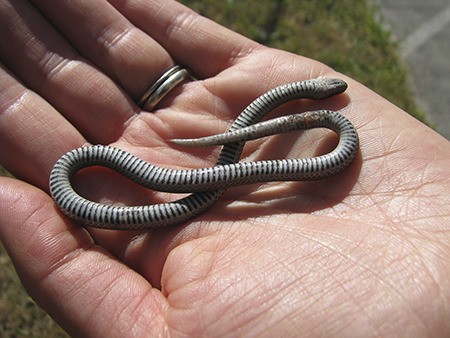A San Juan Island couple, Maria Michaelson and Eben Shay, recorded the first documented sighting of the sharp-tailed snake on San Juan Island when their cat brought it home last Thursday evening.
“It was a totally lucky find,” said Michaelson. “We had just learned about the snakes the day before, and we were determined to find one but didn’t expect for it to happen so quickly, and certainly not this way.”
The snake was carefully collected and will be donated to the University of Washington’s Burke Museum.
Sharp-tailed snakes are a small, secretive species that is presumed to be closely associated with Garry oak ecosystems. Less than five percent of Garry oak habitats remain, which accounts in part for why the snakes are so infrequently encountered. The snakes, which specialize in eating slugs, spend almost all of their time undercover in rotting logs and possibly underground. They are smoother in appearance than the resident garter snakes and have grey/brown/reddish coloration with a sharp thorn-like scale at the end of their tale. Sharp-tailed snakes are non-venomous and very docile.
The first documented occurrence in San Juan County occurred in 2006 on Turtleback Mountain as Land Bank stewards Ruthie Dougherty and Doug McCutchen discovered one under a rock while constructing a trail. Like Michaelson, they recognized the snake as something different from the regular garter snakes encountered in the islands and snapped a picture in order to identify it. Washington State Fish and Wildlife officials confirmed it as the first sharp-tailed snake seen in Western Washington since the 1950s in addition to being the first in the San Juan Islands.
The snakes are listed as an endangered species in Canada where they are known to occur on just four of the Gulf Islands and on the outskirts of Victoria. The snakes are more common towards the southern part of their range in Oregon and California.
Since the original discovery the Land Bank has been working closely with the Washington Department of Fish and Wildlife to survey for the snakes, primarily on Orcas and San Juan. Two more snakes were found on Turtleback Mountain Preserve in 2013. The Land Bank and WDFW are also collaborating with the University of Washington’s Conservation Canine program to use their trained “scent detection” dogs to try locating the snakes.
Contact Ruth Milner or Doug McCutchen if you are interested in helping survey your property for this species. For information: www.env.gov.bc.ca/wld/documents/shtsnake_IDguide_web.pdf




